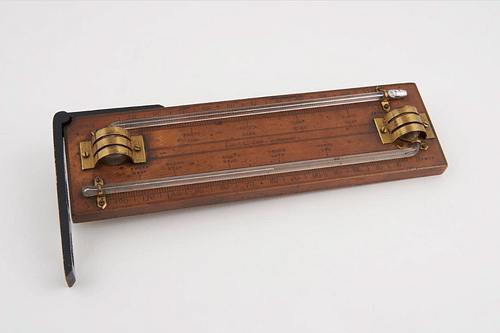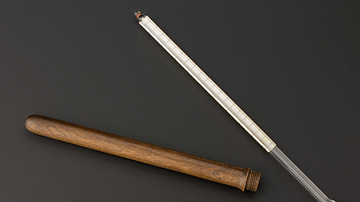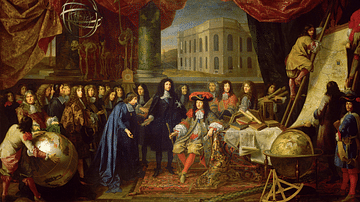The Scientific Revolution (1500-1700) was driven by several key inventions, all scientific instruments that became essential to achieving a greater understanding of the world around us. With instruments like the telescope, microscope, thermometer, and pendulum clock, scientists could see what had never before been seen and measure results of experiments much more accurately than had ever been possible before.
The consequence of this activity using scientific instruments was a reformulating of long-held and often erroneous theories ranging from how the blood system of the human body worked to what the surface of the Moon really looked like.
Six key inventions of the Scientific Revolution are:
- the telescope
- the microscope
- the pendulum clock
- the thermometer
- the barometer
- the air pump
The above were all part of "a collection of technical instruments that became catalysts for scientific advance in the course of the seventeenth century" (Jardine, 9). Natural philosophers became scientists when they used these inventions collaboratively to determine how the world about us really works, rather than how previous philosophers had imagined it to be so. Experimenting, measuring, recording, and subjecting these findings to the scrutiny of peers (via the printing press and private correspondence) ensured that a new scientific method was adopted, and it was so successful that it is impossible today to think of a scientist who does not use instruments of one kind or another. "New instruments meant new perceptions, and with them came new knowledge" (Wootton, 560).
The Telescope
The telescope was invented around 1608, with the Dutchman Hans Lippershey (c. 1570 to c. 1619) usually credited as its inventor. The device was remarkably simple and used a convex lens and a concave lens – one magnifying and the other miniaturising – set at either end of a long tube. It was the Italian Galileo Galilei (1564-1642), though, who perfected the instrument, greatly improving the possible magnification to around 33 times. Galileo observed for the first time the surface of the Moon, and he saw both mountains and valleys, just like on Earth. The Italian spotted four moons of the planet Jupiter, identified the phases of Venus, and observed sunspots, which led him to believe the Sun was a revolving sphere. Less powerful telescopes were also used on land and at sea to view the far horizon, especially useful to armies and navies.
The German astronomer Johannes Kepler (1571-1630) perfected Galileo's design by using two convex lenses, which resulted in a clearer image (albeit now upside down to the viewer). The English scientist Isaac Newton (1642-1727) then invented the reflecting telescope in 1668. This type used a curved mirror made of a metal alloy, which improved the clarity of the image and meant the tube could be much shorter. Aerial telescopes did away with the tube altogether so that the two lenses could be placed much further apart and so achieve even greater magnification. At the other end of the scale, miniature telescopes were fitted to existing navigational instruments like the quadrant. Telescopic sights were often fitted with wires (micrometers) to measure very small movements or changes in angle of the object in view. More and better telescopes meant observatories were purpose-built to house them, such as in Paris (1667) and Greenwich, London (1675).

Ever-improving telescopes made it possible to see thousands of new stars, which seemed to suggest the universe was infinite. The telescope allowed astronomers to test many of the conflicting theories regarding the heavenly bodies against the physical evidence of detailed and prolonged observation. The models of the universe proposed by Aristotle (384-322 BCE) and Claudius Ptolemy (c. 100 to c. 170 CE) were overturned in favour of that proposed by Nicolaus Copernicus (1473-1543), where the Sun was placed at the centre of our galaxy and not the Earth. Other benefits of astronomy using telescopes included a much more accurate calculation of the calendar and far more accurate star charts for navigators. Finally, the instrument got inventors thinking about what else magnifying lenses might be useful for.
The Microscope
The microscope was born from the telescope since it uses the same principles of magnification and miniaturisation. The invention is usually credited to the Dutchman Cornelius Drebbel (1572-1635) or Hans Janssen. Specialist manufacturers included the Englishman John Marshall, who designed the compound microscope, which has three lenses (eyepiece, field lens, and objective lens) and the possibility to add crucial extra light using a candle under the base. Some microscopists made their own instruments, perhaps most famously the Dutchman Antonie van Leeuwenhoek (1632-1723), who made over 500 microscopes. Leeuwenhoek made microscopes that had an impressive magnification of 270 times, using a tiny glass bead instead of a larger and flatter lens. Further adaptations to improve the instrument were made, such as adding a small mirror to the base, whose angle could be adjusted to direct more light to the specimen under view. The English instrument maker Edward Culpeper (1670-1737) made this mirror concave, increasing the light made available in his microscopes.
Anatomists, entomologists, and botanists were particularly keen to use this new invention to further their understanding of the natural world. Many then published beautifully illustrated works, which revealed to the public exactly what could be seen through the latest microscopes. It now became clear that a tiny insect could be just as complex in its structure as a large mammal. One such illustrated book, Micrographia, published in 1665 by the Englishman Robert Hooke (1635-1703), caused a sensation. The Italian Marcello Malpighi (1628-1694) used a microscope to discover capillaries in 1661, which confirmed William Harvey's discovery of blood circulation. Leeuwenhoek discovered red blood cells, protozoa, and spermatozoa. Many others made equally astonishing discoveries. It had to be admitted, though, that seeing these things did not necessarily mean an understanding of their significance was realised. The microscope had revealed a whole new world, but more investigations and more instruments were needed to gain a more complete understanding of the significance of what could now be seen through a lens.
The Pendulum Clock
Sundials and water clocks were largely replaced by mechanical clocks from the end of the 13th century, but these were still not accurate enough to measure minutes; indeed, many did not even have a minute hand. Scientists, particularly the astronomers now armed with their telescopes, needed a much more accurate way of recording time. Galileo drew a design for a pendulum clock, but the first working model was made in 1657 by Christiaan Huygens (1629-1695). In a pendulum clock, the regularity of the pendulum's swing precisely controls the falling of a weight. The best pendulum clocks lost a maximum of 15 seconds per day compared to 15 minutes with a mechanical clock.
Astronomers could now more accurately calculate the movement of heavenly bodies, and many observatories were fitted with one or more pendulum clocks. Greater accuracy in timekeeping meant scientists conducting experiments in different places could more reliably compare their data. New things could be measured, such as falling objects in gravity tests, velocity over short distances, and the more refined movements of the planets. Timekeeping became even more accurate with the invention in 1675 of watches using a balance spring, which reproduced the action of a pendulum in a confined space and was not susceptible to sharp movements of the device. Keeping good time suddenly became more important to everyone, not just scientists, and many people converted their mechanical clocks to the pendulum version and bought themselves a pocket chronometer. The great intricacy of clocks led to them being used as a common metaphor for anything complex, and their mechanisms would later inspire engineers in the British Industrial Revolution to invent new machines like the steam engine.
The Thermometer
The thermometer, like the previous instruments mentioned, revolutionised ideas and practices. Previously, there was no way to measure temperature besides a rather vague range of three conditions: cold, normal, and hot. The great ancient physician Galen (129-216 CE), for example, only had four grades of temperature based on the two extremes of ice and fire. Precision was the watchword of the Scientific Revolution, and so the thermometer was invented in the early 17th century, although we do not know who did so. The early thermometers were of the thermoscope type, that is, a narrow tube was filled with water which moved up (or down) a scale when the air below (or above) it was heated and so it expanded, pushing up (or down) the liquid. The thermoscope thermometer had some problems since it did not give precise readings and was susceptible to variations in air pressure.
It was around 1650 at Florence's Academia del Cimento that inventors struck on the idea of having the liquid in the thermometer expand and not the air. The first models used alcohol in a sealed and very thin glass tube. In order to take the readings on the provided scale more easily, the alcohol was coloured. This instrument became known as a Florentine thermometer and replaced the thermoscope type by the end of the 17th century. The Florentine scientists had made experiments with mercury instead of alcohol but went for the latter because it is more sensitive to temperature change. The drawbacks of alcohol were that, in the 17th century, it was not so easy to acquire absolutely pure alcohol and that it has a low boiling point. These two negatives meant that the thermometers of the day were not always as accurate as might have been hoped for by their users, and, certainly, it was difficult to compare more precise readings between different thermometers. Still, this was a great step forward, and the next challenge was to ensure everyone used the same measuring scale so that the results of experiments could be exchanged and compared in the growing international scientific community.
Some institutions made sure experimenters used the same temperature scales, but it took until the 18th century before two scales came to dominate: Fahrenheit, proposed by the German Daniel Gabriel Fahrenheit (1686-1736), and Celsius, proposed by the Swede Anders Celsius (1701-1744). The thermometer became an indispensable instrument in many different fields of science. For example, doctors could now precisely track the ups and downs of their patients' illnesses, and chemists could measure the properties of the substances they worked with and compare the setup of their apparatus with established temperature charts.

The Barometer
The barometer was invented in 1643 by the Italian Evangelista Torricelli (1608-1647), when, working with Vincenzo Viviani (1622-1703), he tried to find how high mercury could be raised within a glass tube when one end of that tube was placed in a container of mercury. The air pressure on the mercury in the container pushed the mercury in the tube up around 30 inches (76 cm) higher than the level in the container. In 1648, Blaise Pascal (1623-1662) and his brother-in-law Florin Périer conducted experiments using similar apparatus, but this time tested under different atmospheric pressures by setting up the devices at a variety of positions on the side of a mountain (Puy-de-Dôme in the Massif Central). The scientists noted that the level of the mercury in the glass tube fell the higher up the mountain readings were taken.
It was the Anglo-Irish chemist Robert Boyle (1627-1691) who gave this mercury pressure reader, then known as a mercurial tube, its lasting name: barometer. It was also Boyle who conclusively demonstrated the effect of air pressure by using a barometer inside an air pump (see below) where a vacuum was established. Boyle formulated a principle which became known as "Boyle's Law". This law states that the pressure exerted by a certain quantity of air varies inversely in proportion to its volume (provided temperatures are constant).
The next piece in the barometer puzzle came from experiments conducted by Otto von Guericke (1602-1686), who noted that air pressure varied depending on the weather. Once it was realised that mercury could be used to measure air pressure, better barometers were developed, which used a measuring scale and mixed the mercury with other substances to increase its sensitivity. The barometer had developed thanks to an international mix of inventors, and it became invaluable to surveyors and meteorologists, in particular.
The Air Pump
The air pump, a device that could remove air from a sealed container, was first publicly demonstrated in 1654 by Otto von Guericke. This device was made of two bronze hemispheres, but it could not permit the introduction of anything inside. An air pump where this was possible was made by Robert Hooke, who had been commissioned to do so by Robert Boyle. The instrument allowed specimens to be placed inside a glass dome and then subjected to different air pressures. Hooke had built an early model in 1659. Boyle and Hooke conducted all kinds of experiments, subjecting plants and living organisms to variations in air pressure. These experiments, often made in front of a public audience, caused a sensation at Royal Society gatherings. In 1671, Hooke even built an air pump large enough to put himself inside it. "Fortunately for Hooke, the pump performed middlingly, emptying only about a quarter of the air from the container. The sensations he reported when he came out of his airless container were giddiness, deafness, and pains" (Jardine, 56). These effects were a lot less deadly than those used on countless living creatures subjected to the ruthless curiosity of scientists. Boyle published the results of his air pump experiments in his 1660 book New Experiments Physico-Mechanical Touching the Spring of the Air, and Its Effects.
Boyle and Hooke were able to demonstrate how a vacuum could exist, for a time called the "vacuum Boylianum". Not everyone agreed that Boyle had created a vacuum in his glass dome using an air pump or even that such a thing could exist at all; Thomas Hobbes (1588-1679) was the most vocal opponent of Boyle's work with vacuums. Boyle's work on air pressure, especially his law and experiments with pressure gauges and pistons, was important since it proved an inspiration to the creators of the steam engine that literally and figuratively powered the British Industrial Revolution from 1710 onwards.
Into the Future
There was a debate as to whether these new scientific instruments could be trusted and whether what they revealed was not mere trickery. Some argued that evidence from such instruments, even if they required the human eye, was not the same as evidence gained from directly using the senses. Others argued that instruments like the telescope and microscope were showing humanity what should not be seen since God had given us perfectly good eyes to view the world, and to pry deeper was not humanity's place and was considered somehow impious. For others, scientific instruments revealed the incredible detail and ingeniousness of life on Earth, and so one could, they thought, only wonder even more at God's work.
The new scientific instruments meant that discoveries came thick and fast, often causing bewilderment at just how complex life could be. Telescopes at one end of the scale and microscopes at the other revealed that a whole new system of measurement was required for the human mind to grasp the scale of the wonders of the visible universe. Most new discoveries with the microscope did not yet help practical medicine, which remained concerned with cures. The telescope was used to prove existing theories wrong, but the microscope merely revealed a whole new set of theories now had to be created. Better clocks had transformed timekeeping but were still not accurate enough to solve the longitude problem. In many ways, technology was frustratingly behind what scientists required to better measure, assess, and understand their specific fields of inquiry. Even after the Scientific Revolution, then, science still had a long way to go to convince many of its true value in improving the human condition.










